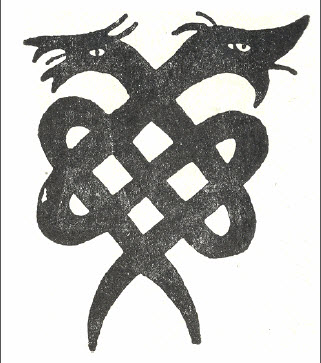
Since its emergence in 1919 as an independent state, the legendary home of the Afghans continues to intrigue the world, as it suffers from the complexities associated with identity and modern political designs. As scholars and information professionals continue to witness the perseverance of Afghans, the immeasurable loss of Afghanistan’s intellectual and publishing culture is yet to be seen in full view. This guide to the National Bibliography of Afghanistan is not intended to be comprehensive in scope. It is, however, a compilation of materials and resources, which will enable scholars to track published materials on Afghanistan in the vernacular languages. Due to the scarcity of some of the sources listed in this research guide, annotations and bibliographic data were produced via card catalog entries for listed sources. This guide is divided into four sections: Library Catalogs, General Resources, Monographic resources, and Periodical Resources. As Afghanistan struggles to revive its printing culture and restore its print and online collections, researchers are encouraged to consult the following: the Afghanistan Digital Library, Afghanistan Center Library Catalog at Kabul University, and the Arthur Paul Afghanistan Collection at the University of University of Nebraska-Omaha.
Publishing
The printing press in Afghanistan emerged in the late 1860s during the reign of Shīr Alī Khan. The emir inaugurated the printing age with the purchase of lithograph printing equipment from British India. Afghanistan’s first book, Vaʿẓ-nāma (approximately 90 pages total with 6 1/2 pages of introduction), was published in Kabul in 1877. Around this time, another title, Usῡl va qavāʿid-i-ʿaskarī (approximately 79 pages total with 8-9 pages of Persian introduction, maps and illustrations, and translation of English texts into Pashto) was also published. During the last decades of the nineteenth and early twentieth centuries, Afghanistan’s publishing output began to gain momentum. A compilation of early serial publications affirms Afghanistan’s transformation:
1. Shams an-nahār: first Afghan newspaper published around 1873[Note: estimation based on issue frequency] [a weekly, 16 pages per issue, 32X20 cm];
2. Sirāj al-akhbār: this newspaper started around 1905 out every 15 days, initially had 12 pages, then within 6 months, it reached 16 pages. At the end of the year, subscribers received a small book. During the first year, the newspaper was printed in a lithographic manner, but already from the second issue it was printed typographically and as accompanied by several well-executed illustrations. Subject matter: post office, telegraph, telephone, railroads and their importance, cars and methods of their production, astronomy, meteorology, geology, even brief articles on linguistics;
3. Sirāj al-aṭfāl: first children’s newspaper in Afghanistan. The newspaper had a format of 4 pages;
4. Amān-i Afghān: a weekly newspaper, had 12 pages. It was printed using the typographical method and included photographic illustrations. In 1928 (1307), the editor was killed during the unrest in Jalāl ābād and the newspaper was closed, not having completed its 8th year.
5. Ittiḥād-i Mashriqī: this newspaper was founded by the ruling emir, Muhammad Nadir Khan, and its first issue, which was the result of the sessions of the National Assembly, came out during the 8th day armistice of the war of independence circa 1920 [as stated in Bertel’s work]. This newspaper was published well into the 1930s and attempted to familiarize the Afghan reader with the various representatives of the Western literature and the Pushtu language. This publication richly represented German literature, from famous authors such as Goethe, to much lesser known figures such as Theodor Storm. According to E. Ė. Bertel’s, this newspaper, in the contemporary opinion of the Afghans, was the best newspaper at that time;
6. Sitāra-yi Afghān: a daily newspaper, which was published in 1921. Unlike the other newspaper publications, it attempted to respond to all of the events of the day and covered humor and satirical description of issues in the country. As a result, this newspaper was closed by the order of the police in 1921(1300)[as stated by Bertel’s];
7. Ittifāq-i-Islām: first newspaper published in Herat. It began its publication in 1921(1299). It was a weekly, it had four pages and printed lithographically. This newspaper continued well into the 1930s;
8. Bīdār-i Mazār: first newspaper published in Mazār-i-Sharīf. It began publishing in 1921 (1300) under Ittihad i Islam. Printed lithographically, it came out weekly and had two pages.
9. Ṭulῡʿ-i Afghān: first Pashtu newspaper published in Qandahar. It was a weekly newspaper and it was circulated well into the late 1920s;
10. Ittiḥād (=Iṣlāh): established in 1922, this publication was printed on a single sheet of colored paper. It continued publishing its fourth and fifth issues in 1931(1310);
11. Irshād an-nisvān: first women’s journal, whose editorial board was composed of women, who were hiding under the pseudonym “a” and “l” [Arabic letters]. The first issue was published on February 18, 1922 (1299). The journal lasted no more than 5-6 months;
12. Afghān: first daily newspaper in Afghanistan. This newspaper came into circulation on July 5, 1920 (1299) and ceased to exist in the beginning of 1923;
13. Al-Ghāzī: started in the southern region of Afghanistan. In 1919, this publication set a goal for itself to unite the Afghan tribes. It was published once a week and consisted of four pages. It ended publication in the end of March, 1921(1299);
14. Akhbār-i ḥaqīqat: Publication of the Ministry of War, which was published especially for the inclusion of information on the fight with the Hazāra insurgents. It was printed lithographically and consisted of four pages. The first issue was published on July 13, 1924 (1303) and the last issue was published on July 8, 1925 (1304);
15. Sarvat: this title was published in Kabul as a bimonthly publication. It was printed lithographically. The first issue was unveiled in 1924 (1303) and consisted of 8 pages. This publication ended after ten months of circulation.
16. Nasīm-i Saḥar: the first purely literary newspaper, which was established in Kabul in 1927. It was published as a weekly and consisted of two pages, later changed to four pages. Overall, this newspaper produced fifteen issues total. It was closed for political reasons;
17. Naurῡz: the first scientific periodical. Established in 1928, it began in circulating in Kabul. There were nine issues total. Due to an uprising, this journal was obliged to close. Questions of religious nature were the primary ones discussed on its pages;
18. Maktab: the first journal meant especially for school children. It began to be published in Kabul around 1929. The two main parts of the paper were devoted to science and literature, the other one to humor. Originally, the paper consisted of two pages, but later increased to four pages.
19. Anīs: Established in Kabul in 1927. During its 6 year existence, this newspaper went from a bimonthly to a weekly. From issues 8-9 onward, this newspaper began to include illustrations. This newspaper resembled a socio-political journal. It published articles on education, politics, and supported commentaries;
20. Muʿrif-i Maʿārif: the first journal of the ministry of education. This journal started publishing as monthly in 1919. The first issue had 30 pages, but increased to 60 pages with the second issue. Lasted for three years and during the last year, there were only 7 issues. It ceased publication in 1922 (1301).
22. Majmῡʿa-yi urdῡ-yi afghān (= Majmῡʿa-yi ʿaskarī): this was the first military monthly journal in Afghanistan. The first came published in 1921 and contained 33 pages. The publishing body was the General Staff. There were approximately 30-50 pages in each issue. The journal published good quality illustrations;
23. Āyīna-yi ʿirfā: A monthly publication of the ministry of national education, which started circulating in 1924. The journal was printed lithographically and contained 48 pages;
23. Mājmῡʿa-yi ṣihhiya: a monthly medical journal published by the medical administration in 1927. The main purpose of the journal was to disseminate basic knowledge of medical issues and the issues of hygiene. Thus, the journal does not contain original research, so it cannot be considered a scientific journal. All the material was based on popular western European medical literature;
27. Puštῡnžagh = Ṣadā-yi-afghān: this journal was designed as a monthly special on Afghan folklore with emphasis on customary laws, oral literature and the material culture of tribal life. It started publication in 1928 in Kabul area. This journal had parallel editions in Persian [Dari] and Pushto. This journal ceased publication after the first issue;
28. Iqtiṣād: this journal was devoted to economics and circulated twice a month. The first issue was published in 1931 [1310]. Initially it had 24 pages per issue, then from issue 9-10, it was shortened to 20 pages, but its format was enlarged;
29. Nayy ʿalā-l-falāḥ: a monthly publication dedicated to the issues of religion. The first issue was published in 1930 (1309) under the supervision of a representative of the clergy. This journal consisted 48 pages. Its main purpose was to warn the reader from being fascinated with the West and the mechanical copying of the western culture;
30. Harāt: literary monthly of the Harāt literary circle. It was published in 1930s and consisted of 40 pages [41×33 cm].
Source: Bibliografiia Vostoka (vyp. 5-6, 1934) [See: E.Ė. Bertel’s, “Afganskaia pressa,” pp. 9-26]. E. Ė. Bertel’s lists publication frequency, names of editors, topical coverage, and the language of publication.
Lithographs (books) printed during 1870-1901 period are listed in G. F. Girs’ work, “Pervye pechatnye knigi Afganistana,”[in Pamiatniki istorii i literatury vostoka, Moskva, 1986, the list appears on pp. 115-132], with the following information: title translation in Russian, author, language of publication, place of publication, annotation, and physical description. Researchers interested in Afghan publications should also consult Ali Ahmad Saber’s work, A Guide to magazines and newspapers of Afghanistan from 1252-1356 (1873-1977) [Kabul: University Printing Press, 1977].
Kitābshināsī-i millī-i Afghānistān = National Bibliography of Afġānistān
Anjuman Ketab Khana-e-Afghanistan (Library Association of Afghanistan) was established in 1971 by Abdul Rasul Rahim, “a former Kabul University Librarian.” Anjuman Ketab Khana-e-Afghanistan’s national objectives included the following: “to promote literacy and libraries in Afghanistan”; “…to improve the status of librarians and to lobby for a national library system and for a School of Library Science in Kabul University.” The library Association also embarked on compiling a national bibliography for Afghanistan, which it “irregularly published.” In 1977, Muhammad Ibrahim Stwodah [Muhammad Ibrahim Sutudah] and Ahmad Zia Modarrissi’ [Ahmad Ziya Mudarrisi] published their compiled work, Kitābshināsī-i millī-i Afghānistān [Afghanistan’s National Bibliography (annotated) July 17, 1973-August 17, 1977]. The national bibliography was published by Kabul University Library as “Library Series no. 11.” The national bibliography‘s scope included “…all publications since the proclamation of the Republic in Afghanistan, in July 17, 1972 (26 of Saratan, 1352) to the time of publishing this [bibliography]” [Source: World Encyclopedia of Library and Information Services (Third Edition, Chicago, 1993), “Afghanistan,” pp. 36-38; Kitābshināsī-i millī-i Afghānistān, “Preface,” pp. 1-2]. The traumatic events of the past thirty five years have prevented Afghanistan from fully restoring the publication of a national bibliography. Since the fall of the Taliban, restoration projects have began to offset the damage caused military conflict at Kabul University Library, the “unofficial” national library of Afghanistan. Researchers interested in the development of libraries in Afghanistan should consult Edward R. Reid-Smith’s work, “Library development in Afghanistan”[UNESCO bulletin for libraries, v. 28, no. 1, January-February, 1974, pp. 17-21]. For information on the condition and restoration projects currently underway at Afghan libraries, see Rosemary Talab’s work, “Kabul University Library in Afghanistan: Postwar Emergence”[International Leads, v. 16, no. 3, 2002], and Nancy Hatch Dupree’s work, “Libraries in [Afghanistan]” [International Preservation News, no. 19, 1999, pp. 20-26].
LIBRARY CATALOGS
Afghanistan Center Library Catalog at Kabul University
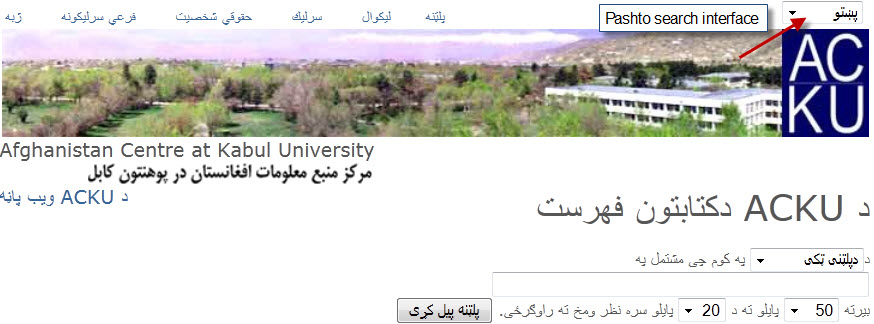
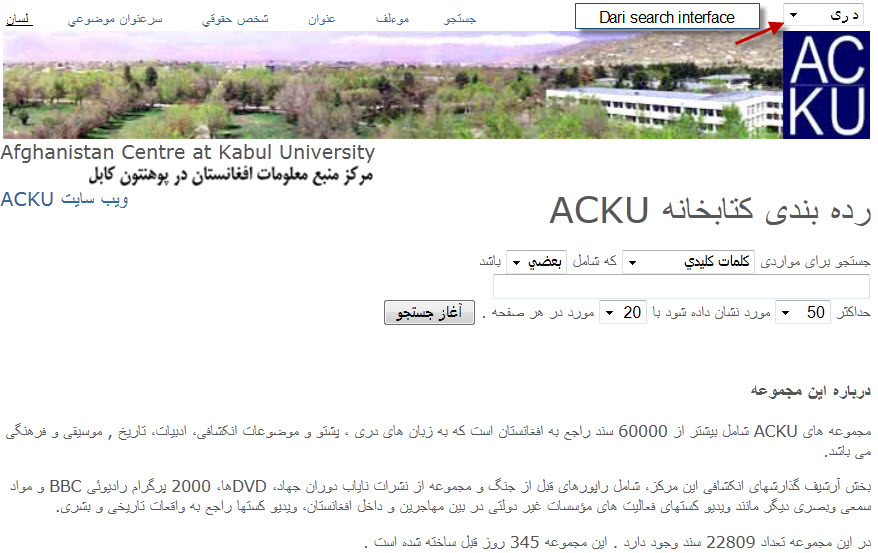 The Afghanistan Center at Kabul University contains approximately 50, 000 volumes on all aspects of Afghanistan, including: literature, music, and cultural heritage. The collection encompasses works in Dari, Pashto, and European languages. In addition to the main collection, the library has reference and archival sections, which include: “… rare Mujahideen press publications, DVDs, 2000 BBC radio programmes and audio visual materials, such as videotapes on NGO activities among refugee populations and inside Afghanistan, historic events and anthropological documentaries.” These sections contain approximately 23830 documents. The entire collection is organized according to the Library of Congress Classification system. Researchers can search the collection using the English, Dari, and Pashto language interface. Moreover, the library catalogue supports the following search/browse options: keyword search, author, title, corporate body, Library of Congress Subject Headings, and by language. Scholars can access Afghanistan Center Library Catalog at: http://acku.edu.af/
The Afghanistan Center at Kabul University contains approximately 50, 000 volumes on all aspects of Afghanistan, including: literature, music, and cultural heritage. The collection encompasses works in Dari, Pashto, and European languages. In addition to the main collection, the library has reference and archival sections, which include: “… rare Mujahideen press publications, DVDs, 2000 BBC radio programmes and audio visual materials, such as videotapes on NGO activities among refugee populations and inside Afghanistan, historic events and anthropological documentaries.” These sections contain approximately 23830 documents. The entire collection is organized according to the Library of Congress Classification system. Researchers can search the collection using the English, Dari, and Pashto language interface. Moreover, the library catalogue supports the following search/browse options: keyword search, author, title, corporate body, Library of Congress Subject Headings, and by language. Scholars can access Afghanistan Center Library Catalog at: http://acku.edu.af/
Afghanistan Digital Library Catalog
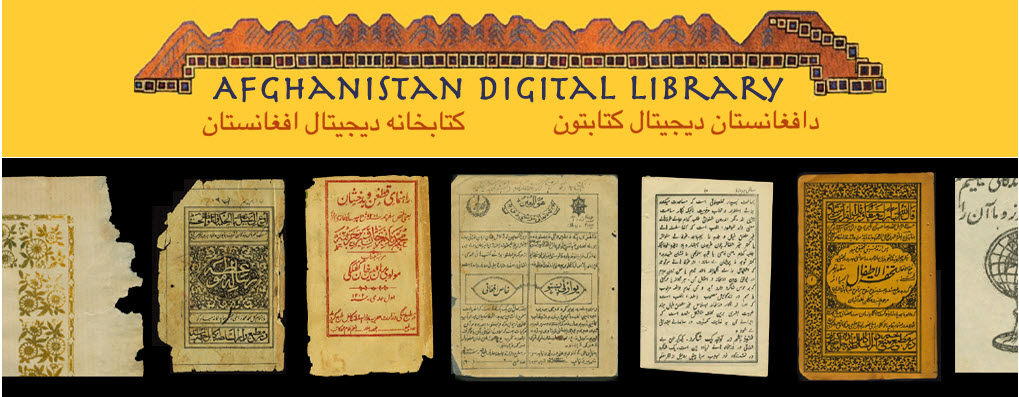 In terms of accessing materials published in Afghanistan during 1871-1930 period and beyond, the Afghanistan Digital Library holds an impressive collection of monographs, serials, pamphlets, and archival materials, open to researchers through a searchable online catalog. The main search interface also supports browsing, which might be helpful to scholars who are not familiar with the vernacular languages of Afghanistan or the transliteration tables used to cataloged these materials. The compilers have attached three helpful bibliographies for researchers. Before searching or browsing the digital library catalog, you can view the bibliographies for Books, Newspapers, and Documents[Bibliography note: these lists were compiled in 2007] found in the Afghanistan Digital Library.
In terms of accessing materials published in Afghanistan during 1871-1930 period and beyond, the Afghanistan Digital Library holds an impressive collection of monographs, serials, pamphlets, and archival materials, open to researchers through a searchable online catalog. The main search interface also supports browsing, which might be helpful to scholars who are not familiar with the vernacular languages of Afghanistan or the transliteration tables used to cataloged these materials. The compilers have attached three helpful bibliographies for researchers. Before searching or browsing the digital library catalog, you can view the bibliographies for Books, Newspapers, and Documents[Bibliography note: these lists were compiled in 2007] found in the Afghanistan Digital Library.
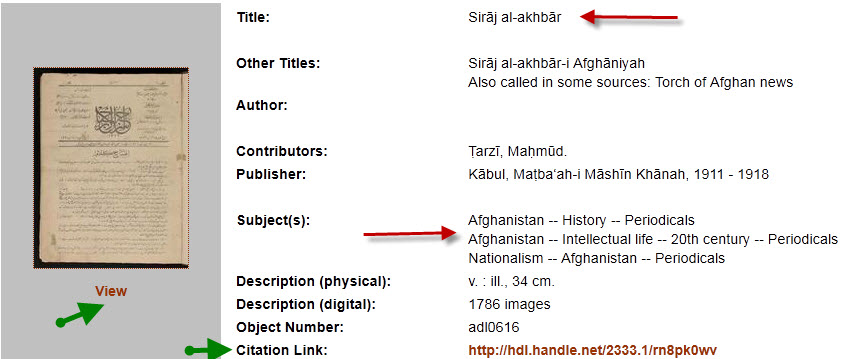
Catalogue of Pashto manuscripts in the libraries of the British Isles: Bodleian Library; the British Museum; Cambridge University Library; India Office Library; John Rylands Library; School of Oriental and African Studies; Trinity College Dublin.
Blumhardt, James Fuller; Mackenzie, D.N. London: The Trustees of the British Museum and the Commonwealth Relations Office, 1965. OCLC Accession Number: 6739643.
 This catalogue consists of 170 Pashto manuscript works from the eighteenth to late nineteenth century: “sixty-nine are in the British Museum,” “sixty in the India Office Library,” “sixteen in the John Rylands Library,” “ten in the School of Oriental and African Studies,” “eight in the University Library, Cambridge,” “five in the Bodleian Library,” and “two in the Library of Trinity College, Dublin.” The compilers have divided the catalogue into the following sections: Religion, History, Philology, Poetry, Tales, and Numerical Index. In addition to the numerical index, the compilers have included an index of titles (p.137), an index of persons (p.139), and their system of transcription. The “works cited” page includes other catalogues of Persian Manuscripts found in the British Libraries. Each entry is annotated with bio-bibliographical data, date of publication [Note: publication year in the Islamic and Gregorian Calendars] and a brief discussion of the manuscript’s content and physical description. This catalogue of 170 Pashto manuscript works would be an excellent guide to the literary tradition of Afghanistan in the eighteenth and the late nineteenth century.
This catalogue consists of 170 Pashto manuscript works from the eighteenth to late nineteenth century: “sixty-nine are in the British Museum,” “sixty in the India Office Library,” “sixteen in the John Rylands Library,” “ten in the School of Oriental and African Studies,” “eight in the University Library, Cambridge,” “five in the Bodleian Library,” and “two in the Library of Trinity College, Dublin.” The compilers have divided the catalogue into the following sections: Religion, History, Philology, Poetry, Tales, and Numerical Index. In addition to the numerical index, the compilers have included an index of titles (p.137), an index of persons (p.139), and their system of transcription. The “works cited” page includes other catalogues of Persian Manuscripts found in the British Libraries. Each entry is annotated with bio-bibliographical data, date of publication [Note: publication year in the Islamic and Gregorian Calendars] and a brief discussion of the manuscript’s content and physical description. This catalogue of 170 Pashto manuscript works would be an excellent guide to the literary tradition of Afghanistan in the eighteenth and the late nineteenth century.

GENERAL RESOURCES
Rahnama-yi tarikh-i Afghanistan: mushtamil bar zikr va sharh-i…jild-i kitab-i chappi va khatti-i ‘Arabi, Dari, Pashtu, Urdu, Turki dar’barah-i tarikh-i Afghanistan. Volume 1-2. Series:Anjuman-i Tārikh-i Afghānistān, 94.
Habibi, ‘Abd al-Hayy. Kabul: Kābul, Dawlatī Maṭbaʻah, 1348- [1970]. OCLC accession number: 505741417
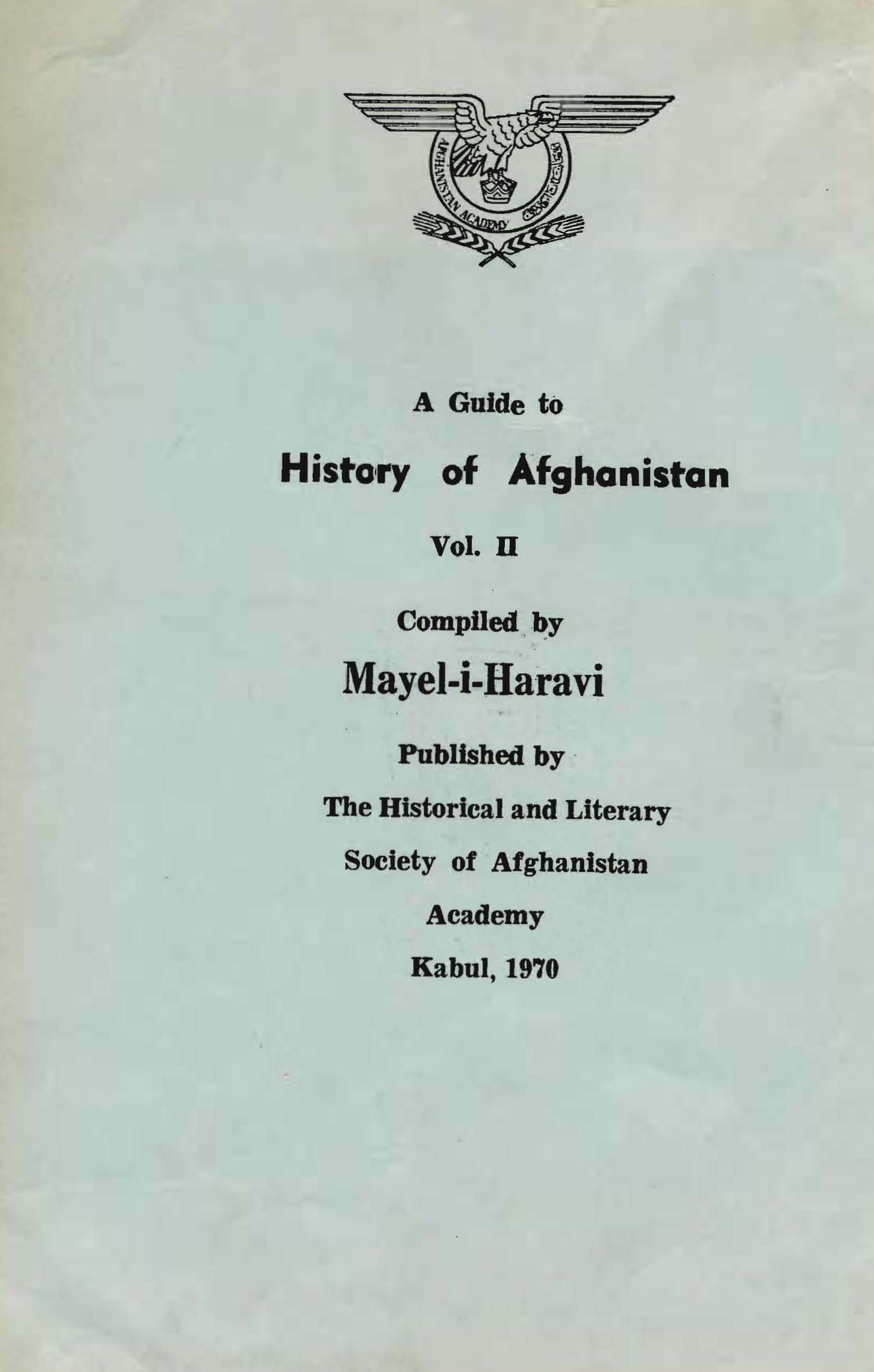
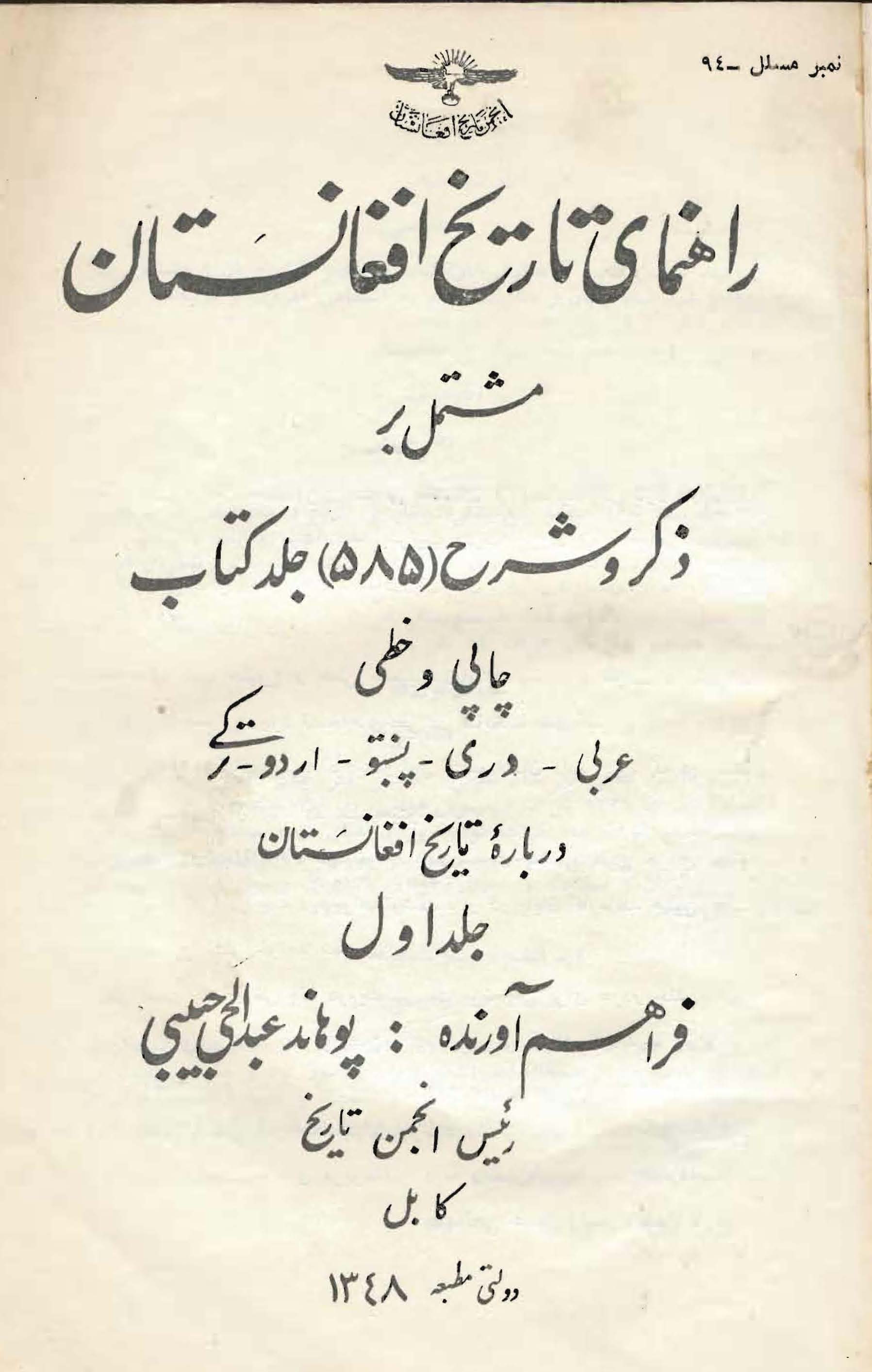 Published in 1970 by the Literary and Historical Society of Afghanistan, this bibliographical guide to Afghan history consists of “585 printed and manuscript books in Arabic, Dari, Paxto, Urdo, and Turky” [Arabic, Dari, Pashto, Urdu, and Turkish]. The titles are listed in alphabetical order with language notes and brief annotations. This bibliography also includes a list of title “corrections.”
Published in 1970 by the Literary and Historical Society of Afghanistan, this bibliographical guide to Afghan history consists of “585 printed and manuscript books in Arabic, Dari, Paxto, Urdo, and Turky” [Arabic, Dari, Pashto, Urdu, and Turkish]. The titles are listed in alphabetical order with language notes and brief annotations. This bibliography also includes a list of title “corrections.”
Arbeitsgemeinschaft Afghanistan und Deutsches Orient-Institut. Bibliographie Der Afghanistan-Literatur 1945-1967. Volume One: Literatur in Europäischen Sprachen. Volume Two: Literatur in Orientalischen Sprachen. Hamburg, 1968-1969. List of periodicals: Volume One: pp. 9-21; Volume Two: pp. 10-14]. Author Index [Volume One: pp. 177-189; Volume Two: pp.197-208].
OCLC accession number: 911500
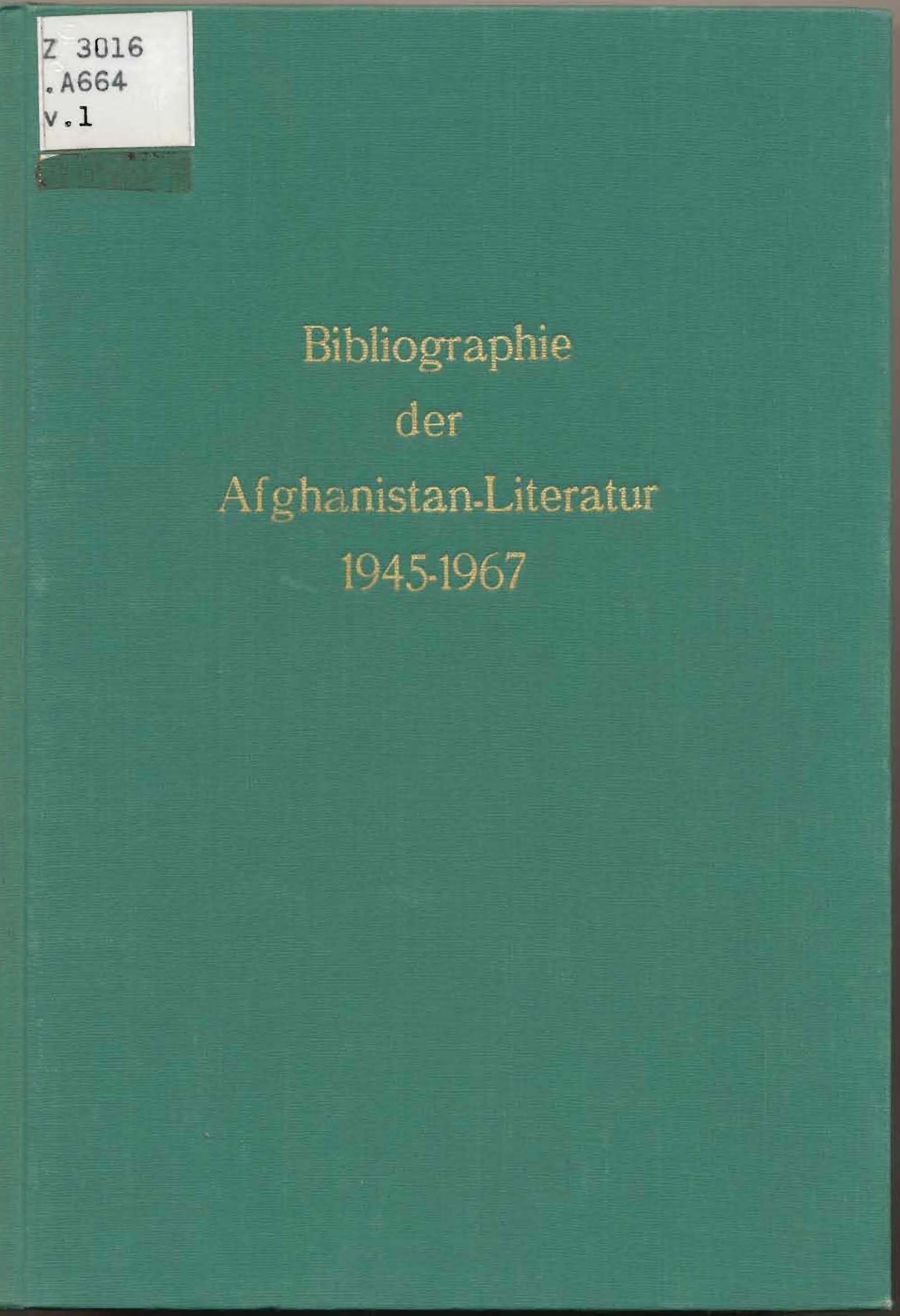
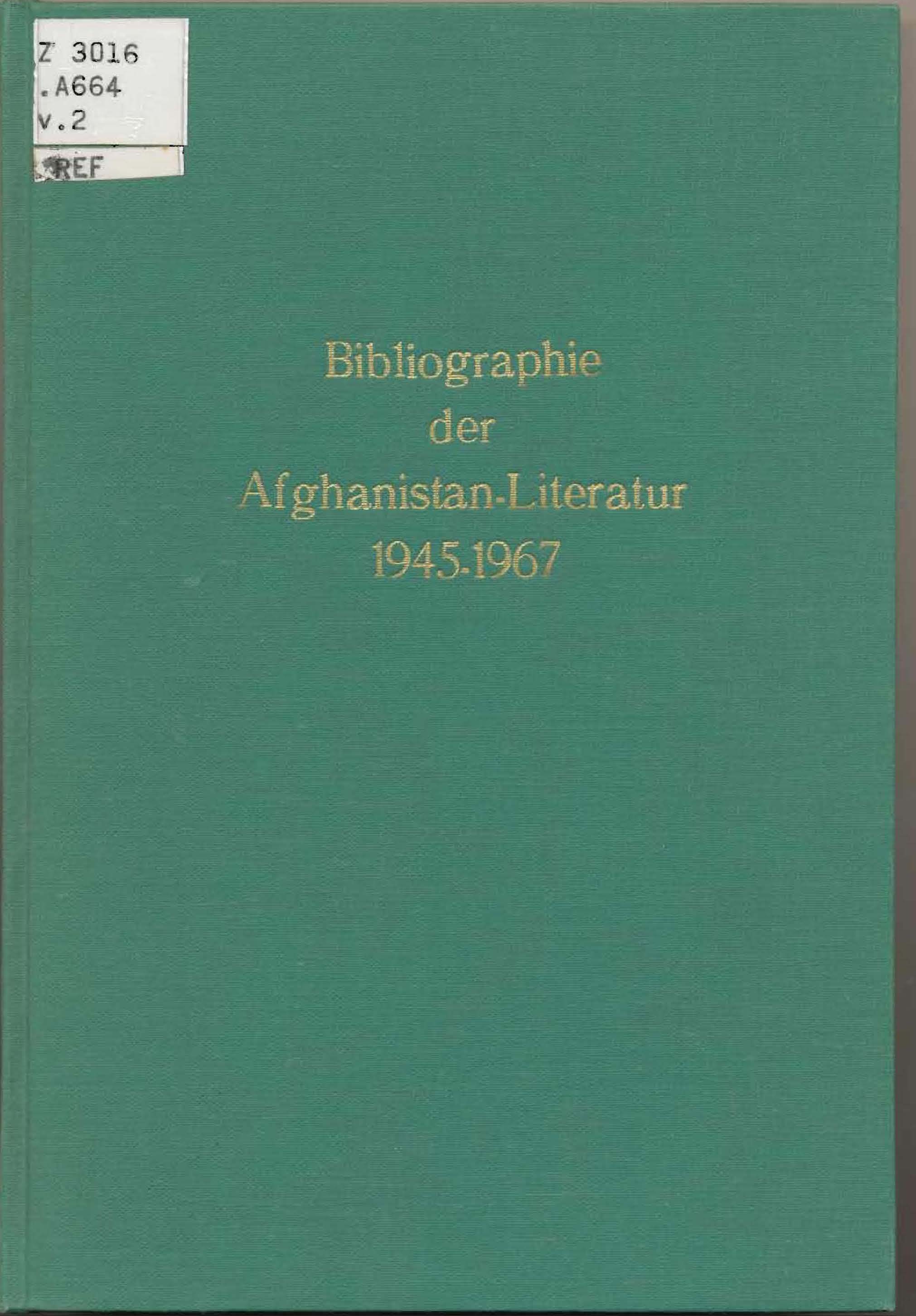
With 4488 entries [Volume One: 2342; Volume Two: 2146], this bibliography “presents the largest number of titles ever collected in one single bibliography on Afghanistan.” Both volumes are divided into 26 sections and each section carries a letter designation (A-Z). Among the twenty six categories, scholars would find the following sections to be of particular interest: “Etnologie und Ethnographie, Anthropologie”[Volume I, pp.83-90; Volume II, pp. 94-96]; “Biographien”[Volume I, pp. 173-174; Volume II, pp. 176-182]; “Periodika” [Volume I, pp.183- 196; Volume II, pp. 175]; “Sprache und literatur”[Volume I, pp. 104-109; Volume II, pp. 112-140]. The compilers have also cross-referenced other sections for researchers. Volume Two, with its emphasis on vernacular language publications, would be extremely beneficial to scholars researching Afghanistan during this period (1945-1967).
Pashtu bibliography [Pashtu].
Rafi, Habibullah. Kabul: Ministry of Information and Culture, 1977(1356).
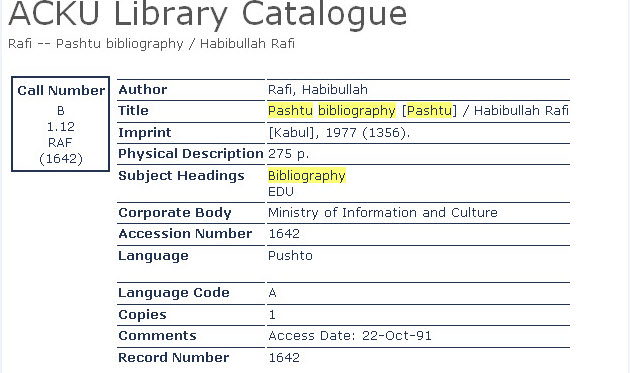
Pashtu bibliography [Pashtu]
Yawn, Mohammad Ismail. Peshawar: Khushal Cultural Association, 1997(1376)
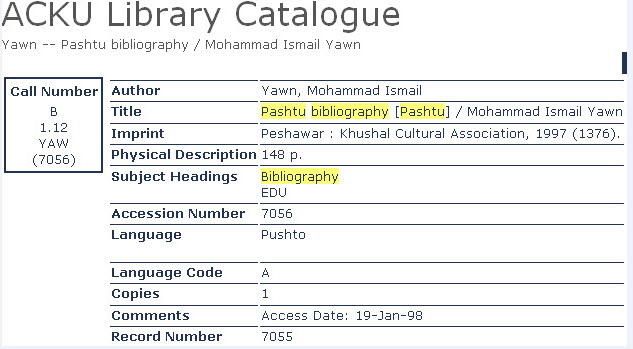
Fihrist-i asnād-i tārīkhī-i Arshīf-i Millī-i Afghānistān = Bibliography of the historical documents of the National Archives of Afghanistan [Persian].Najrabi, ‘Abd Allah.
Kabul: Kumitiyah-i Dawlati-i Tab` va Nashr-i J.D.A, 1986. Format: Microfiche. Location: Center for Reserach Libraries, Holdings Record
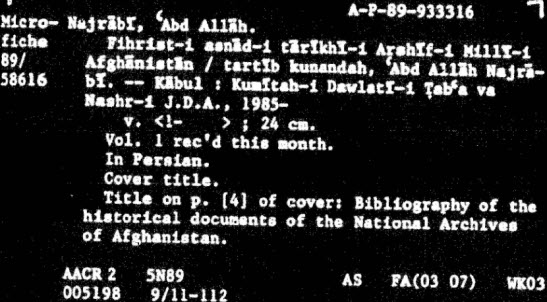 Published in 1986, this Bibliography of Historical Documents of the National Archives of Afghanistan is organized numerically. Each entry contains the following: name of the document, subject, date of publication, description of the document, and a brief annotation.
Published in 1986, this Bibliography of Historical Documents of the National Archives of Afghanistan is organized numerically. Each entry contains the following: name of the document, subject, date of publication, description of the document, and a brief annotation.
MONOGRAPHIC RESOURCES
Fihrist-i kutub-i matbū’-i Afghānistān az sāl-i 1330 ila 1344, 15 sāl. Catalogue of printed books from Afghanistan: fifteen years from1951-1965 [Dari, Pashtu].
Herawai(Heravī), Māyil. Kabul: Government Printing Press, 1965 (1344). Source: ACKU Catalogue.
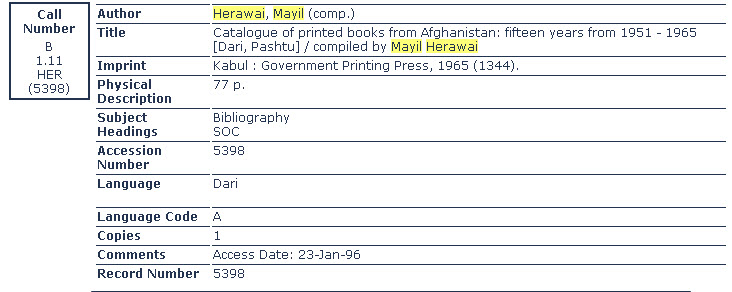
Fihrist-i kutub-i chāpī-i Darī-i Afghānistān. The Catalogue of Dari printed books in Afghanistan [Dar ī].
Nā’ il, Husayn. Kabul: Historical Society of Afghanistan, 1977 (1356). Source: ACKU Catalogue. OCLC Accession Number: 27919854; 252091384.
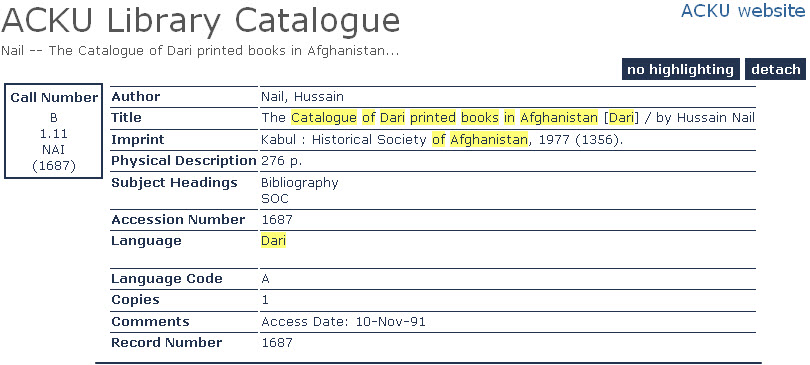
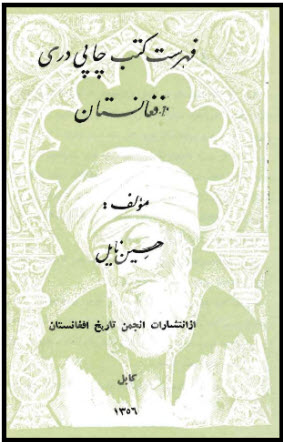
This bibliography lists about 1200 of the approximately 2000 printed books in Darī to have been published in Afghanistan.
Kitābshināsī-i millī-i Afghānistān : mawz̤ūʻī tawṣīfī, 26 Saraṭān 1352 tā imrūz = National Bibliography of Afghānistān (annotated): July 17, 1973 – August 17, 1977 [Dari, Pashtu]. Series: Kabul University Library Series 11.
Stwodah, Mohammad Ibrahim; Modarrissi, Ahmad Zia. Kabul: Kabul University, 1977 (1356). OCLC Accession Number: 251885842.
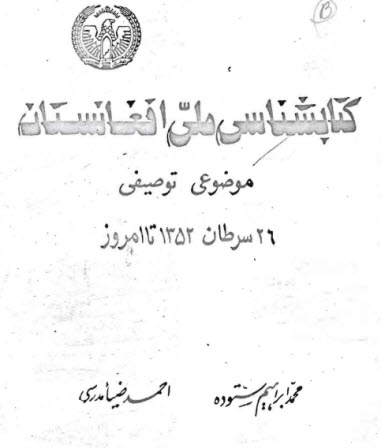
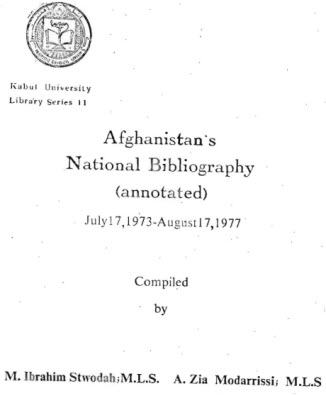
Compiled by M. Ibrahim Stwodah and A. Zia Modarrissi, Afghanistan’s national bibliography(annotated) “aims to cover all publications since the proclamation of the Republic in Afghanistan, in July 17, 1973 (26 of Saratan, 1352) up to the time of publishing this [bibliography].” The entries are listed in “alphabetical order under different subjects.” The 230 entries also contain annotations in either Pusto, Dari or English. Using the Dewey Decimal Classification, the compilers have organized the national bibliography by subject. In addition to the subject categories, the national bibliography also includes an “index of titles.”
Arthur Paul Afghanistan Collection Bibliography. Volume One: Pashto and Dari titles. Volume Two: English and European languages.
Wahab, Shaista. Lincoln, Neb.: Dageforde Publishers, 1995-2000. ISBN: 1886225079 (v.1), 1886225516 (v.2). Please Note: v.2 is digitized. Volume One [Available ONLINE]. Volume Two [Available ONLINE]. Full list of digitized materials(English Language) at the Arthur Paul Afghanistan Collection. List includes the following publications: Kabul Times. Collection note: Arthur Paul Afghanistan Collection is managed by the University of Nebraska-Omaha. Researchers can view the main website at: http://digitalcommons.unl.edu/afghanuno/
The Arthur Paul Afghanistan Collection at the University of Nebraska “is the largest collection of Afghan materials in the country.” Collection description: “Mr. Paul [1898-1976] served as an economic advisor to the Royal Government of Afghanistan from 1960 to 1965. During his service in Afghanistan, he collected Afghanistan materials for his private library. His collection of Afghanistan materials included published and unpublished materials on all subjects and disciplines pertaining to Afghanistan. The University Library has made extensive efforts to further enrich the collection. Currently the Arthur Paul Afghanistan Collection holds more than 12,000 titles. There are approximately 814 Pashtu and Dari titles listed in volume one. Moreover, volume two contains approximately 2585 titles and includes an author/title index. The entries in both volumes are numerically organized and the author names are listed alphabetically. The Collection contains materials on all subject areas pertaining to Afghan life and culture, which includes economics, education, folklore, law, agriculture, language, architecture, geology, geography, history and literature. Documents in this collection are in more than 24 different languages. However, the majority of the materials are in English, Persian/Dari, and Pashto languages.”
PERIODICAL RESOURCES
Rahnama-yi majallat, jatadid va ruznama-ha-yi Afganistan, 1252-1356 / A guide to magazines and newspapers of Afghanistan from 1252-1356 (1873-1977).
Saber, Ali Ahmad. Kabul: University Printing Press, 1977 (1356). Language: Dari. OCLC Accession Number: 499252626.
Ali Ahmad Saber’s guide to magazines and newspapers of Afghanistan (1873-1977) is held in the reference section of the British Library and the Afghanistan Center Library at Kabul University.
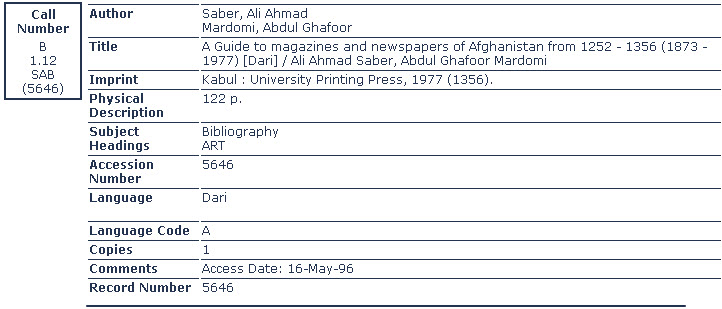
Persian and Afghan newspapers in the Library of Congress, 1871-1978.
Pourhadi, Ibrahim Vaqfi. Washington, D.C.: Library of Congress, 1979. ISBN: 0-8444-0283-4 U of I Library Call Number: International & Area Studies Asian Reference Z6958.I65 P87 1979. Indexes: Chronological Index[p.93]; Index of Places of Publication[p.97]; Name Index [p. 98]. The Full text is available through Hathi Trust Digital Library. Please click here for the link.
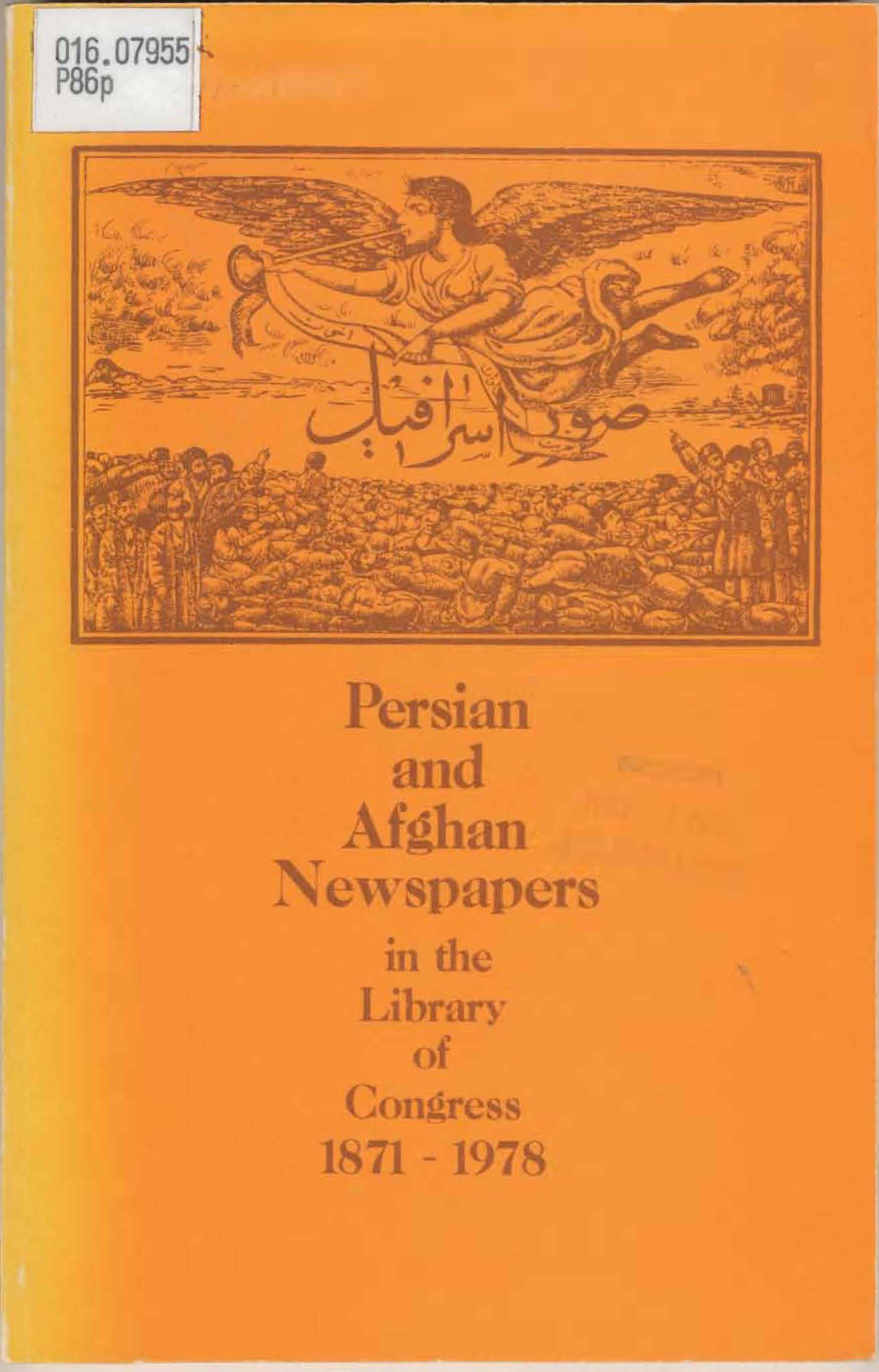 Published in 1979, this bibliography “lists all the newspapers from Iran and Afghanistan in the holdings of the Library of Congress in alphabetical order.” Ibrahim V. Pourhadi’s insightful guide utilizes thirteen categories to classify Iranian newsapers at the Library of Congress: The “First Category” of newspapers starts with Mirza Saleh Shirazi, ” who in January1837 lithographed the first monthly newspaper in Iran.” The other eleven categories are: Second Category [1906-1908, first Iranian constitutional period]; Third Category [1926-1941, “reign of Reza Shah Pahlavi]; “Fourth Category” [ 1945-51 period]; Fifth Category [1941-1953, newspapers published by the “Tudeh party”]; Sixth Category [Mossadeq and the nationalization period]; Seventh Category [ newspapers of “religious orientation]; Eight Category [“ephemeral papers, bulletins, announcements, communiques, etc]; Ninth Category[1905-11 and 1953, “newspapers and periodicals published outside Iran”]; Tenth Category [ “publications that advocate an end to Iran’s traditional monarchy’]; Eleventh Category [“newspapers published by the Iranian students abroad”]; Twelfth Category [“discuss Iran’s role in international affairs”]; Thirteenth Category [“general domestic and foreign news”]. Afghan Newspapers Section [pp. 84-89, Entries A1-A23] : In addition to the holdings information, each entry contains the following: the language of the newspaper, place of publication, publisher/owner of license information, and dates of publication. After each entry, Mr. Ibrahim Pourhadi, through brief annotations, provides the researcher with valuable background information on each publication.
Published in 1979, this bibliography “lists all the newspapers from Iran and Afghanistan in the holdings of the Library of Congress in alphabetical order.” Ibrahim V. Pourhadi’s insightful guide utilizes thirteen categories to classify Iranian newsapers at the Library of Congress: The “First Category” of newspapers starts with Mirza Saleh Shirazi, ” who in January1837 lithographed the first monthly newspaper in Iran.” The other eleven categories are: Second Category [1906-1908, first Iranian constitutional period]; Third Category [1926-1941, “reign of Reza Shah Pahlavi]; “Fourth Category” [ 1945-51 period]; Fifth Category [1941-1953, newspapers published by the “Tudeh party”]; Sixth Category [Mossadeq and the nationalization period]; Seventh Category [ newspapers of “religious orientation]; Eight Category [“ephemeral papers, bulletins, announcements, communiques, etc]; Ninth Category[1905-11 and 1953, “newspapers and periodicals published outside Iran”]; Tenth Category [ “publications that advocate an end to Iran’s traditional monarchy’]; Eleventh Category [“newspapers published by the Iranian students abroad”]; Twelfth Category [“discuss Iran’s role in international affairs”]; Thirteenth Category [“general domestic and foreign news”]. Afghan Newspapers Section [pp. 84-89, Entries A1-A23] : In addition to the holdings information, each entry contains the following: the language of the newspaper, place of publication, publisher/owner of license information, and dates of publication. After each entry, Mr. Ibrahim Pourhadi, through brief annotations, provides the researcher with valuable background information on each publication.